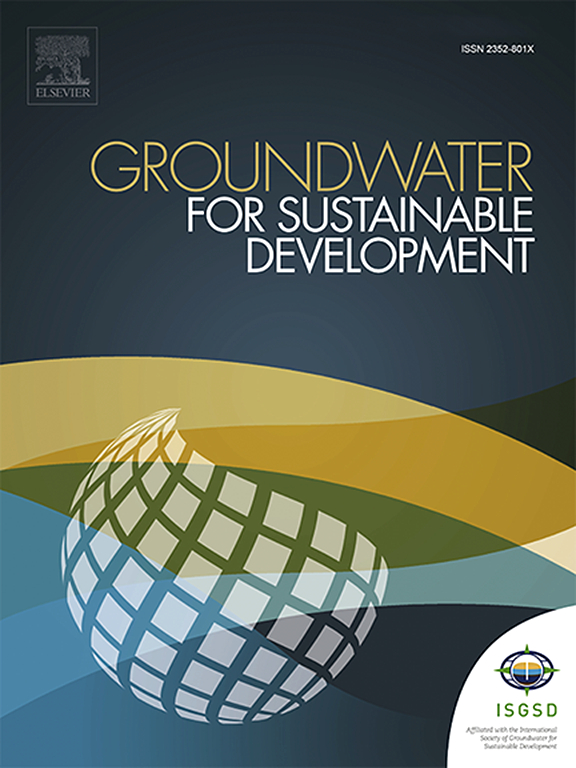Land subsidence in Mexico City: New insights from field data and numerical modeling
IF 4.9
Q2 ENGINEERING, ENVIRONMENTAL
引用次数: 0
Abstract
Water supply to Mexico City relies mainly on groundwater from a regional aquifer overlain by highly compressible lacustrine sediments. Intensive pumping has originated land subsidence, threatening water supply and damaging urban infrastructure. A research site where the thickness of the aquitard reaches 100 m, was instrumented with piezometers, benchmarks and extensometers and monitored for 10 years. Data are analyzed to understand the main drivers and quantify their contribution to the process of land subsidence in Mexico City. Total settlement amounted to 3.661 m, at an average rate of 0.314 m/year. Increase in total stress due to new infrastructure built near the site (a highway) at the start of the monitoring period amounts for 35% of the observed total settlement; this deformation takes place from 0 to 36 m within the aquitard, where pore pressure maintained a hydrostatic distribution. Our analysis shows that the main driver for land subsidence is groundwater pumping from the regional aquifer as most of the deformation due to consolidation (2.128 m) was registered below a depth of 82 m. Since the thickness of the aquitard at the research site is 100 m, numerical simulation shows that most of this deformation most probably takes place at interbedded compressible lenses within the regional aquifer. Future modeling efforts in Mexico City need to consider this process.

墨西哥城的地面沉降:来自实地数据和数值模拟的新见解
墨西哥城的供水主要依赖于由高度可压缩的湖泊沉积物覆盖的区域含水层中的地下水。密集抽水造成地面沉降,威胁供水,破坏城市基础设施。在一个水槽厚度达到100米的研究地点,使用了压力计、基准和延伸计,并进行了10年的监测。对数据进行分析,以了解主要驱动因素,并量化其对墨西哥城地面沉降过程的贡献。总沉降量为3661 m,平均沉降量为0.314 m/年。在监测期开始时,由于在工地附近修建了新的基础设施(一条高速公路),总应力增加占观察到的总沉降量的35%;这种变形发生在水下0 ~ 36 m处,此时孔隙压力保持流体静力分布。我们的分析表明,地面沉降的主要驱动因素是从区域含水层抽取地下水,因为大部分由固结引起的变形(2.128 m)记录在深度82 m以下。由于研究地点的含水层厚度为100 m,因此数值模拟表明,大部分变形极有可能发生在区域含水层内的互层可压缩透镜体上。墨西哥城未来的建模工作需要考虑这一过程。
本文章由计算机程序翻译,如有差异,请以英文原文为准。
求助全文
约1分钟内获得全文
求助全文
来源期刊

Groundwater for Sustainable Development
Social Sciences-Geography, Planning and Development
CiteScore
11.50
自引率
10.20%
发文量
152
期刊介绍:
Groundwater for Sustainable Development is directed to different stakeholders and professionals, including government and non-governmental organizations, international funding agencies, universities, public water institutions, public health and other public/private sector professionals, and other relevant institutions. It is aimed at professionals, academics and students in the fields of disciplines such as: groundwater and its connection to surface hydrology and environment, soil sciences, engineering, ecology, microbiology, atmospheric sciences, analytical chemistry, hydro-engineering, water technology, environmental ethics, economics, public health, policy, as well as social sciences, legal disciplines, or any other area connected with water issues. The objectives of this journal are to facilitate: • The improvement of effective and sustainable management of water resources across the globe. • The improvement of human access to groundwater resources in adequate quantity and good quality. • The meeting of the increasing demand for drinking and irrigation water needed for food security to contribute to a social and economically sound human development. • The creation of a global inter- and multidisciplinary platform and forum to improve our understanding of groundwater resources and to advocate their effective and sustainable management and protection against contamination. • Interdisciplinary information exchange and to stimulate scientific research in the fields of groundwater related sciences and social and health sciences required to achieve the United Nations Millennium Development Goals for sustainable development.
 求助内容:
求助内容: 应助结果提醒方式:
应助结果提醒方式:


